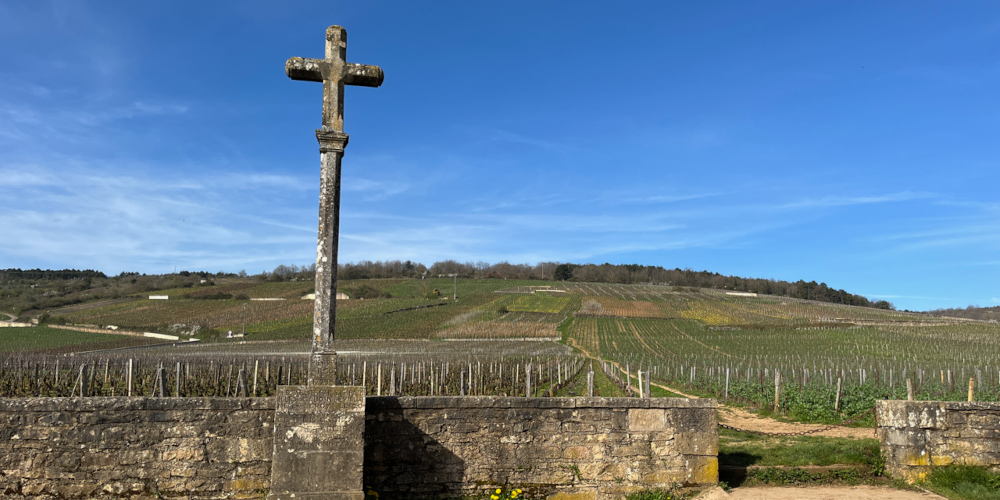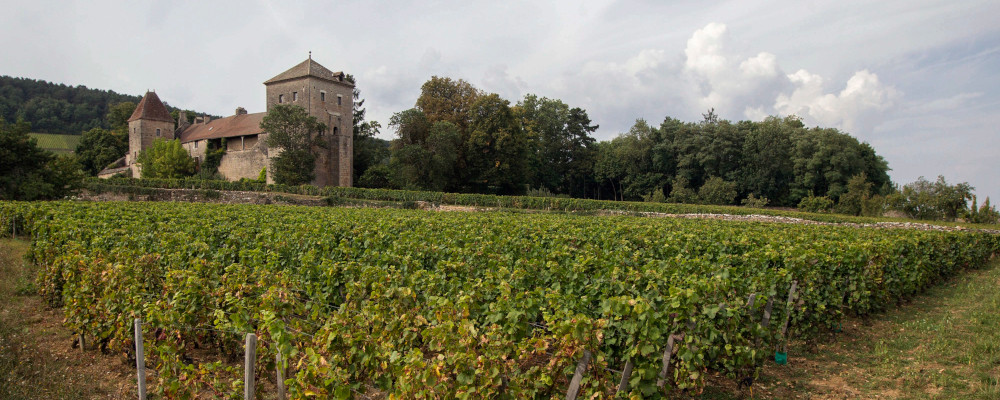Last week I visited the Domaine de la Romanée-Conti in Burgundy, France. By which I mean I drove by the buildings in which the winery is housed, catching a glimpse of what was inside the gates. From that flash observance, we continued out of the village of Vosne-Romanée to the stone cross at a T-junction of a single track road, going up the ridge, that marks the approximate centre of the nine Grands Crus Clos, or walled vineyards, from which the Domaine makes wine. These include Romanée-Conti itself, and the equally famous Richebourg and La Tâche.
The visit was a wino pilgrimage and produced something like the Jerusalem syndrome, wherein an otherwise (more or less) sane oenophile begins to believe he has glimpsed at the holy and sacred and will never swill a stemware quite the same again. Looking at plants had never seemed so profound.
The pilgrimage to the DRC terroir was a half pit stop in a very busy itinerary that made up my trip to participate in and cover Les Grands Jours de Bourgogne. I travelled as a guest of the Bureau Interprofessional des Vins de Bourgogne, which markets and promotes the wines of the region on behalf of its winemaking members. Les Grands Jours is a biennial celebration of Bourgogne wines, including intensive tastings, by appellation, of what’s coming to market. This year it meant tasting a lot of 2022 vintage wines, as well as some 2021 and 2020, but there were always opportunities to taste older vintages here and there.

Back on the clay and limestone-y ground, once I had regained composure, sense prevailed. From the roadside of the low stone walls that enclose the various vineyards from which Grand Cru is made, I saw to the north the Clos Vougeot and its neighbouring castle, and to the south Nuits-St-Georges, all running along a continuous ridge of about 300 meters above sea level. These lieu-dits, these places, are variations on a theme in la Bourgogne (the name in French the Bourguignons fiercely insist English speakers use instead of the more familiar Burgundy1Touchiness among the Bourguignons about what English speakers call this famous French wine region has been a thing for at least the 20 years that I have been professionally writing about wine. I am not entirely clear why precisely, though I was told on this last trip it may have a lot to do with the fact that the French word for the colour Burgundy is “Bordeaux.” As the recipient of limitless hospitality from the vignerons of la Bourgogne, I will honour their wish and keep it en français.), where the “côtes” refer to the sides of the ridge and its contiguous hills that slope eastwardly.
The man who drove me and two colleagues from Quebec past the gates of DRC was Bourgogne expert and guide Nicolas Tacquard. From another vantage point towards the top of the hill, he explained the history of the vineyards of la Bourgogne in a quick summary while we looked at the patchwork or mosaic of different plots stretching around us. In the Middle Ages, when the landed aristocracy in the Duchy of Burgundy wanted a blessing to do something, like go on a crusade, they might donate some land to the local abbey in exchange for the benediction. They inevitably gave the monks this hillside land, stony and steep and unsuitable for important crops like wheat, but good for growing vines, which the monks needed for sacramental wine, anyway.
With the French Revolution came anti-clericalism and the church lands were seized and sold at auction to a new kind of person who had the right to own land called a citizen. As the Republic transformed into Napoleon’s Imperium, the newly codified laws of land inheritance were changed from a system of strict primogeniture, where the eldest son got everything (while his younger brothers went to the military or priesthood), to a mandatory equal division between all male heirs. Within a few generations the vineyards were divided into small holdings so that by today there are something like 4,000 mostly family growers and producers in la Bourgogne. There are also larger landholders and negociants and cooperatives who buy and consolidate grapes from the small holders.
Apart from ownership, throughout la Bourgogne, the land itself is divided into classifications, which refer to the quality, or at least potential, of particular plots. In descending order of importance, they are Grand Cru, Premier Cru, Villages, and Regional. Though not always, the top-tier plots tend to be in the middle of the slopes, where one might find a Goldilocks mix of limestone and clay soils. Further up and the land becomes too stony; further down and it’s not stony enough, since the lighter soils migrate downwards with gravity.
Counterintuitively, the large number of small producers spread around many small spots results in a relative uniformity in winemaking styles. Given the demand for the wines of la Bourgogne and the prices they fetch, this may simply be a case of not wanting to deviate much from the tried and true. It carries for both the red wines, made with Pinot Noir, and the whites, made predominately with Chardonnay but sometimes with la Bourgogne’s lesser-known white grape Aligoté (or, in one small appellation only, Saint-Bris, Sauvignon Blanc).

Typically, Grand and Premier Cru wines will see some new oak and are accordingly built to age. The Villages will see old, large-format oak or other neutral elevations, and the regional (i.e. plain old Vin de Bourgogne) will generally be made simply and ready to go. Variance, as it comes between different wines, even or especially from the same village area, is expressed by differences inherent to the character of the specific place where the grapes to make the wine were grown. These sites are also sometimes called climats, a nod to the importance of the effects of temperature and sun exposure on the maturing of the fruit.
I spent six days in la Bourgogne and tasted hundreds of wines including the traditional method sparkling Crémant de Bourgogne. I began in Auxerres and Chablis which is the northwest pocket of Bourguignon wine appellations around the Yonne River, a tributary of the Seine. Then, based out Beaune, which is more or less between Dijon and Lyon, tasted through from Gevrey through the Côtes and Corton, southwards toward Mercurey, Santenay, and the Macônnais. I will get into greater detail on the wines and some of the people who make them in future posts.
Through the hundreds of wines, at formal tastings, large and small meals, and even a picnic, I don’t remember a single one I didn’t like or questioned the quality of the viticulture or winemaking. The 2022s were a bit chewy and difficult since they are years away from being in their drinking window. Some of them hadn’t even been bottled yet, and others had been just bottled a few weeks before. Still, there was always the presence of fruit and hints of elegance to come. Bourgogne holds its reputation—and the prices that come with it—for good reason. Enjoy them, if you have them.




